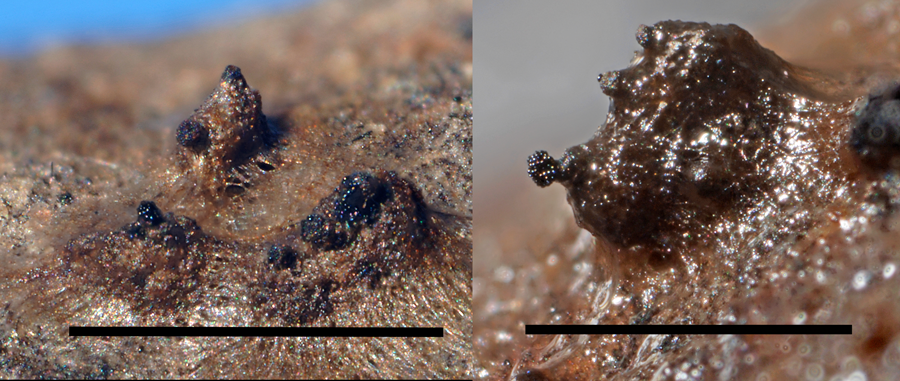BIOFLow International Research Experience for Students (IRES)
Mailing Address
Cleveland State University, Washkewicz College of Engineering
2121 Euclid Ave., WH 305
Cleveland, Ohio 44115-2214
Campus Location
Washkewicz Hall Room 305
2300 Chester Avenue
Phone: 216-687-2555
Fax: 216-687-9280
engineering@csuohio.edu
Website Issues Only
engineering@csuohio.edu
Discharge and dispersal of fungal spores
Background.
Understanding the mechanisms of discharge and dispersal of fungal spores are important for understanding the spread of disease caused by a large number of fungal pathogens. Adaptations in spore shape and launch mechanism [1,2] to exit the boundary layer for passive dispersal by the wind [3] have been studied in some species. One important factor is the role of surface proteins (hydrophobin) that make the spores hydrophobic ADDIN EN.CITE.DATA [2,4-7], which mediates their interactions with the environment and may affect their dispersal success. In the model fungal species Neurospora crassa, the mutant easily wettable (eas), also known as circadian clock-controlled gene-2 (ccg-2), has been characterized intensively [8-9]. Genetic tools available to manipulate N. crassa make it a good candidate for carefully studying the relationship between genetic traits and success in dispersal, as may lead to strategies for inhibiting the spread of fungal diseases.

Figure 1. AscoAscospores ooze, rather than explode, out of perithecia grown on the surface of ironwood bark. The scale bars represent 1 mm. [10]
IRES student involvement.
This project aims to characterize the discharge of ascospores (cell packets of 8 spores) from the fruiting bodies (perithecia) of N. crassa and their eventual breakup and dispersal into free stream flow. Dr. Kwangwon Lee will advise a student on the mycological background of the project at Rutgers. Samples of wild type and eas N. crassa will be grown with natural and synthetic media for 3 weeks in his lab (started before arrival of the student), and transported to Dr. Sang Joon Lee's lab in POSTECH. There, ascospore ejection will be recorded using high-speed, high-magnification imaging with laser illumination in controlled flow conditions. Spores recaptured at varying distances from the perithecia will be analyzed via visual microscopy and SEM to determine the point of ascospore breakup and characterize spore shape, respectively.
References
- Roper, M., Pepper, R. E., Brenner, M. P. & Pringle, A. Explosively launched spores of ascomycete fungi have drag-minimizing shapes. Proc Natl Acad Sci U S A 105, 20583-20588, doi:10.1073/pnas.0805017105 (2008).
- Fritz, J. A., Seminara, A., Roper, M., Pringle, A. & Brenner, M. P. A natural O-ring optimizes the dispersal of fungal spores. J R Soc Interface 10, 20130187, doi:10.1098/rsif.2013.0187 (2013).
- Roper, M. et al. Dispersal of fungal spores on a cooperatively generated wind. Proc Natl Acad Sci U S A 107, 17474-17479, doi:10.1073/pnas.1003577107 (2010).
- Luciano-Rosario, D. et al. The Hydrophobin Gene Family Confers a Fitness Trade-off between Spore Dispersal and Host Colonization in Penicillium expansum. mBio 13, e0275422, doi:10.1128/mbio.02754-22 (2022).
- Macindoe, I. et al. Self-assembly of functional, amphipathic amyloid monolayers by the fungal hydrophobin EAS. Proc Natl Acad Sci U S A 109, E804-811, doi:10.1073/pnas.1114052109 (2012).
- Trail, F. Fungal cannons: explosive spore discharge in the Ascomycota. FEMS Microbiol Lett 276, 12-18, doi:10.1111/j.1574-6968.2007.00900.x (2007).
- Talbot, N. J. Aerial morphogenesis: enter the chaplins. Curr Biol 13, R696-698, doi:10.1016/j.cub.2003.08.040 (2003).
- Bell-Pedersen, D., Lewis, Z. A., Loros, J. J. & Dunlap, J. C. The Neurospora circadian clock regulates a transcription factor that controls rhythmic expression of the output eas (ccg-2) gene. Mol Microbiol 41, 897-909, doi:10.1046/j.1365-2958.2001.02558.x (2001).
- Arpaia, G., Loros, J. J., Dunlap, J. C., Morelli, G. & Macino, G. The interplay of light and the circadian clock. Independent dual regulation of clock-controlled gene ccg-2(eas). Plant Physiol 102, 1299-1305, doi:10.1104/pp.102.4.1299 (1993).
- Lee, K. Asexual and sexual developments of Neurospora crassa on natural substrata. Fungal Ecol. 5, 223–229 (2012).
Mailing Address
Cleveland State University, Washkewicz College of Engineering
2121 Euclid Ave., WH 305
Cleveland, Ohio 44115-2214
Campus Location
Washkewicz Hall Room 305
2300 Chester Avenue
Phone: 216-687-2555
Fax: 216-687-9280
engineering@csuohio.edu
Website Issues Only
engineering@csuohio.edu